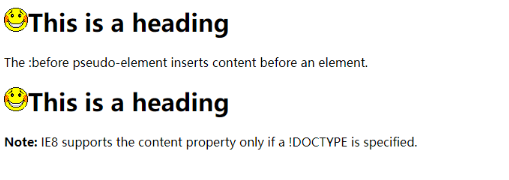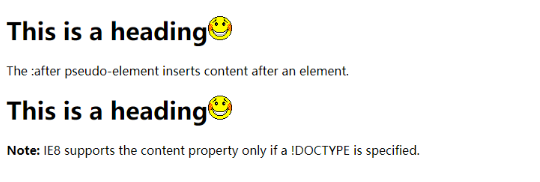CSS伪类,伪元素
一、伪类
CSS伪类是用来添加一些选择器的特殊效果。
语法
伪类的语法:
selector:pseudo-class {property:value;}
CSS类也可以使用伪类:
selector.class:pseudo-class {property:value;}
anchor伪类
在支持 CSS 的浏览器中,链接的不同状态都可以以不同的方式显示
<html>
<head>
<style>
a:link {color:#FF0000;} /* unvisited link */
a:visited {color:#00FF00;} /* visited link */
a:hover {color:#FF00FF;} /* mouse over link */
a:active {color:#0000FF;} /* selected link */
</style>
</head>
<body>
<p><b><a href="/css/" target="_blank">这是一个链接</a></b></p>
<p><b>注意:</b> a:hover 必须在 a:link 和 a:visited 之后,需要严格按顺序才能看到效果。</p>
<p><b>注意:</b> a:active 必须在 a:hover 之后。</p>
</body>
</html>
效果:
注意:
- 在CSS定义中,a:hover 必须被置于 a:link 和 a:visited 之后,才是有效的。
- 在 CSS 定义中,a:active 必须被置于 a:hover 之后,才是有效的。
- 伪类的名称不区分大小写。
伪类和CSS类
伪类可以与 CSS 类配合使用:
a.red:visited {color:#FF0000;}
<a class="red" href="css-syntax.html">CSS Syntax</a>
如果在上面的例子的链接已被访问,它会显示为红色。
CSS - :first-child伪类
您可以使用 :first-child 伪类来选择元素的第一个子元素
注意:在IE8的之前版本必须声明<!DOCTYPE> ,这样 :first-child 才能生效。
匹配第一个 <p> 元素
在下面的例子中,选择器匹配作为任何元素的第一个子元素的 <p> 元素:
<html>
<head>
<style>
p:first-child
{
color:blue;
}
</style>
</head>
<body>
<p>I am a strong man.</p>
<p>I am a strong man.</p>
</body>
</html>
效果:

匹配所有<p> 元素中的第一个<i> 元素
在下面的例子中,选择相匹配的所有<p>元素的第一 <i>元素:
<html>
<head>
<style>
p > i:first-child
{
color:blue;
}
</style>
</head>
<body>
<p>I am a <i>strong</i> man. I am a <i>strong</i> man.</p>
<p>I am a <i>strong</i> man. I am a <i>strong</i> man.</p>
</body>
</html>
效果:
<html>
<head>
<style>
p:first-child i
{
color:blue;
}
</style>
</head>
<body>
<p>I am a <i>strong</i> man. I am a <i>strong</i> man.</p>
<p>I am a <i>strong</i> man. I am a <i>strong</i> man.</p>
</body>
</html>
效果:
CSS - :lang 伪类
:lang 伪类使你有能力为不同的语言定义特殊的规则
注意:IE8必须声明<!DOCTYPE>才能支持;lang伪类。
在下面的例子中,:lang 类为属性值为 no 的q元素定义引号的类型:
<html>
<head>
<style>
q:lang(no) {quotes: "~" "~";}
</style>
</head>
<body>
<p>Some text <q lang="no">A quote in a paragraph</q> Some text.</p>
</body>
</html>
效果:
二、伪元素
CSS伪元素是用来添加一些选择器的特殊效果。
语法
伪元素的语法:
selector:pseudo-element {property:value;}
CSS类也可以使用伪元素:
selector.class:pseudo-element {property:value;}
:first-line 伪元素*
"first-line" 伪元素用于向文本的首行设置特殊样式。
在下面的例子中,浏览器会根据 "first-line" 伪元素中的样式对 p 元素的第一行文本进行格式化:
<html>
<head>
<style>
p:first-line
{
color:#ff0000;
font-variant:small-caps;
}
</style>
</head>
<body>
<p>You can use the :first-line pseudo-element to add a special effect to the first line of a text.</p>
</body>
</html>
效果:
注意:"first-line" 伪元素只能用于块级元素。
注意:下面的属性可应用于 "first-line" 伪元素:
- font properties
- color properties
- background properties
- word-spacing
- letter-spacing
- text-decoration
- vertical-align
- text-transform
- line-height
- clear
:first-letter 伪元素
"first-letter" 伪元素用于向文本的首字母设置特殊样式:
<html>
<head>
<style>
p:first-letter
{
color:#ff0000;
font-size:xx-large;
}
</style>
</head>
<body>
<p>You can use the :first-letter pseudo-element to add a special effect to the first character of a text!</p>
</body>
</html>
效果:
注意: "first-letter" 伪元素只能用于块级元素。
注意: 下面的属性可应用于 "first-letter" 伪元素:
font properties
color properties
background properties
margin properties
padding properties
border properties
text-decoration
vertical-align (only if "float" is "none")
text-transform
line-height
float
clear
伪元素和CSS类
伪元素可以结合CSS类:
p.article:first-letter {color:#ff0000;}
<p class="article">A paragraph in an article</p>
上面的例子会使所有 class 为 article 的段落的首字母变为红色。
Multiple Pseudo-elements
可以结合多个伪元素来使用。
在下面的例子中,段落的第一个字母将显示为红色,其字体大小为 xx-large。第一行中的其余文本将为蓝色,并以小型大写字母显示。
段落中的其余文本将以默认字体大小和颜色来显示:
<html>
<head>
<style>
p:first-letter
{
color:#ff0000;
font-size:xx-large;
}
p:first-line
{
color:#0000ff;
font-variant:small-caps;
}
</style>
</head>
<body>
<p>You can combine the :first-letter and :first-line pseudo-elements to add a special effect to the first letter and the first line of a text!</p>
</body>
</html>
效果:
CSS - :before 伪元素
":before" 伪元素可以在元素的内容前面插入新内容。
下面的例子在每个 <h1>元素前面插入一幅图片:
<!DOCTYPE html>
<html>
<head>
<style>
h1:before {content:url(/images/online_demo/smiley.gif);}
</style>
</head>
<body>
<h1>This is a heading</h1>
<p>The :before pseudo-element inserts content before an element.</p>
<h1>This is a heading</h1>
<p><b>Note:</b> IE8 supports the content property
only if a !DOCTYPE is specified.</p>
</body>
</html>
效果:
CSS - :after 伪元素
":after" 伪元素可以在元素的内容之后插入新内容。
下面的例子在每个 <h1> 元素后面插入一幅图片:
<html>
<head>
<style>
h1:after {content:url(/images/online_demo/smiley.gif);}
</style>
</head>
<body>
<h1>This is a heading</h1>
<p>The :after pseudo-element inserts content after an element.</p>
<h1>This is a heading</h1>
<p><b>Note:</b> IE8 supports the content property only if a !DOCTYPE is specified.</p>
</body>
</html>
效果:
